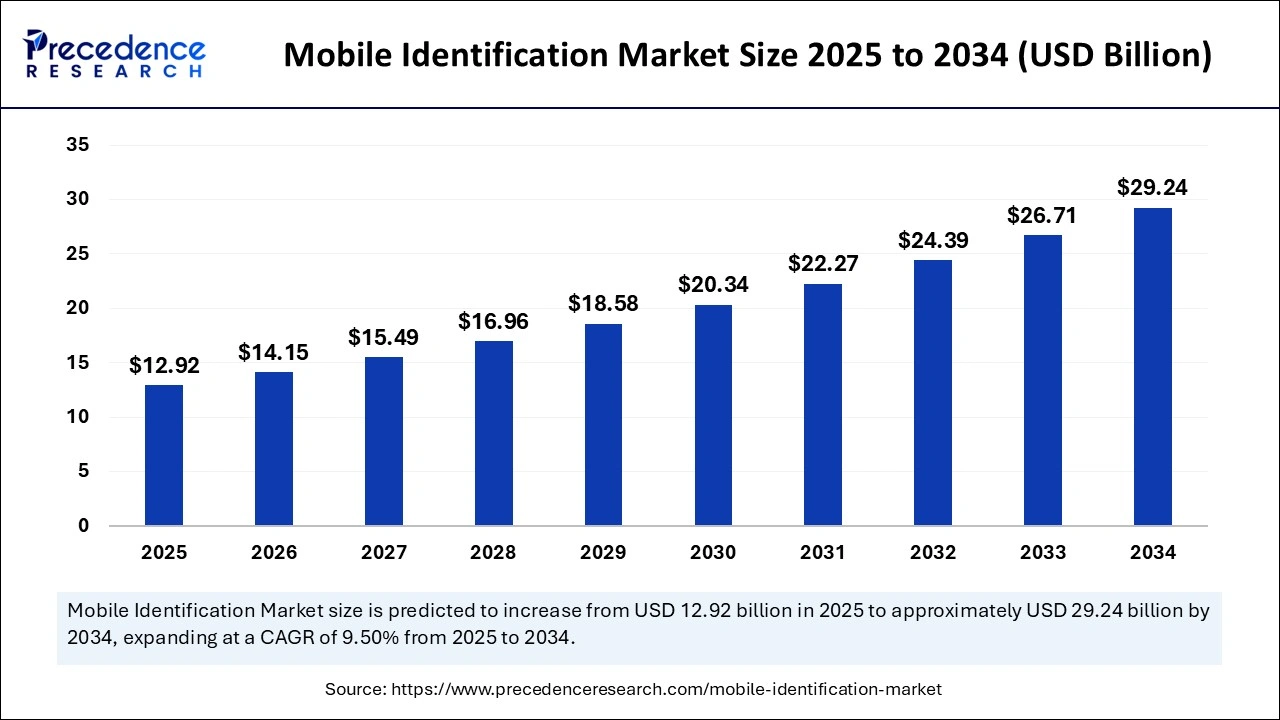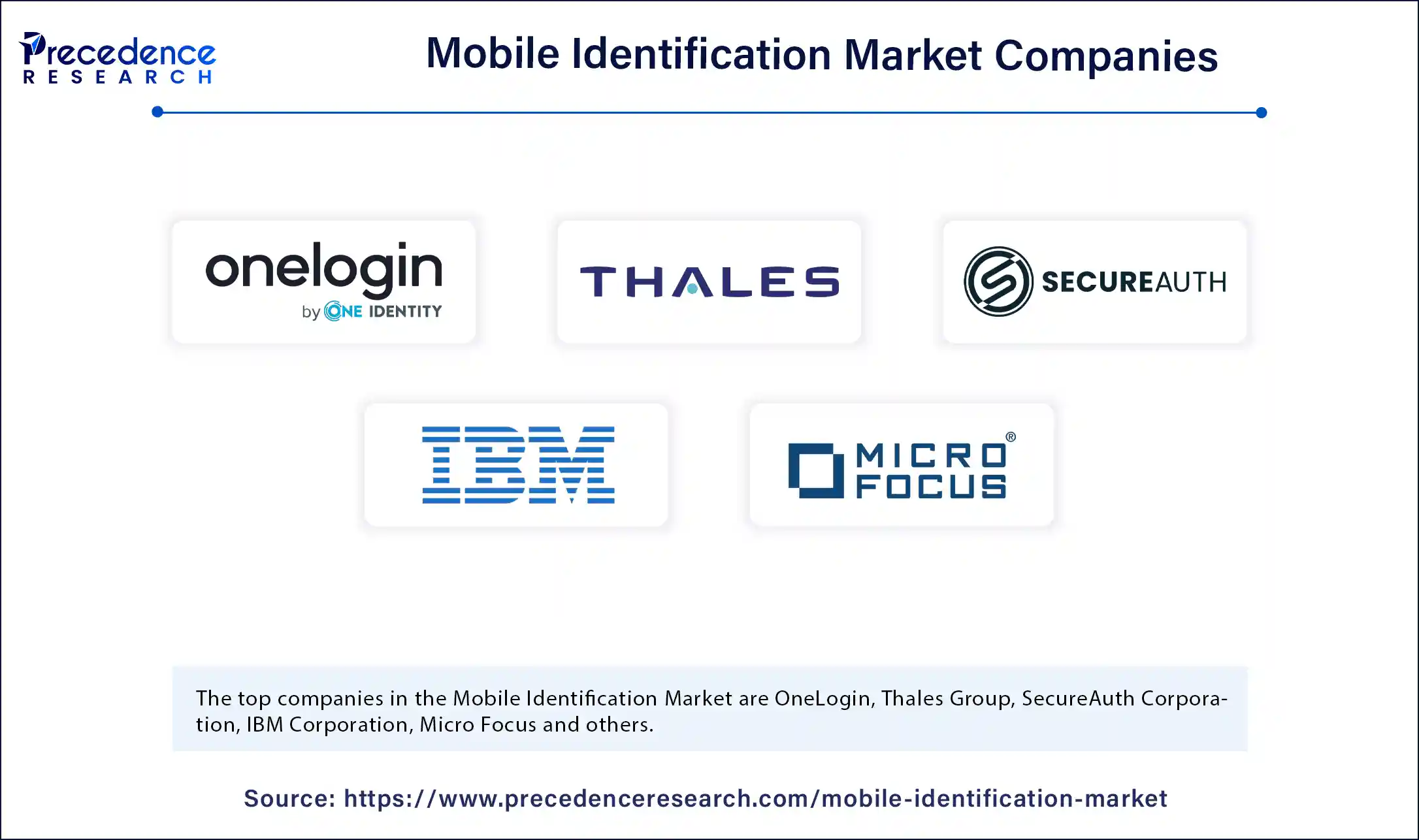The global mobile identification market size is estimated to worth around USD 29.24 billion by 2034 increasing from USD 11.80 billion in 2024, with a CAGR of 9.50%.

Mobile Identification Market Key Points
- North America led the global mobile identification market in 2024, capturing the largest revenue share of 40%.
- Asia Pacific is anticipated to experience the fastest growth throughout the forecast period.
- Based on authentication, the multi-factor authentication segment held the dominant share in 2024, while the single-factor authentication segment is projected to expand significantly in the coming years.
- By component, the biometric segment was the top contributor to market revenue in 2024, whereas the non-biometric segment is expected to witness notable growth from 2025 to 2034.
- In terms of deployment, the cloud segment accounted for the highest market share in 2024, while the on-premises segment is likely to grow at a substantial rate during the forecast timeframe.
- By application, the IT & telecom sector led the market in 2024, while the retail sector is forecasted to grow rapidly in the years ahead.
Mobile Identification Market Overview
The mobile identification market is rapidly evolving as digital transformation, cybersecurity concerns, and regulatory pressures push governments, enterprises, and service providers to adopt secure, scalable, and user-friendly identity verification technologies. Mobile identification refers to systems and platforms that allow individuals to verify their identity through mobile devices—often using biometrics, encrypted credentials, digital IDs, or two-factor authentication mechanisms. These systems are used for access control, digital onboarding, eKYC (electronic Know Your Customer), secure payments, and government services.
Fueled by the increasing penetration of smartphones, the demand for mobile-based authentication and identity management solutions has surged across banking, telecom, healthcare, retail, and travel sectors. With physical IDs proving to be less secure and cumbersome, mobile identification offers a seamless, privacy-preserving, and real-time alternative. Government digital ID programs, such as mobile driving licenses (mDLs), national ID cards with mobile integration, and digital passports, are further expanding the scope of the market. Moreover, the rise of mobile-first economies, especially in Asia and Africa, has made mobile identification a cornerstone of secure digital inclusion and access to essential services.
Mobile Identification Market Growth Factors
The mobile identification market is being propelled by a convergence of technological, regulatory, and behavioral shifts. A primary growth factor is the increased reliance on digital channels for banking, healthcare, commerce, and government interactions, which necessitates secure and remote identity verification. Traditional username-password systems are no longer adequate in protecting against sophisticated cyber threats, leading to a greater emphasis on mobile-centric authentication methods.
Secondly, global regulatory mandates, such as GDPR (General Data Protection Regulation), eIDAS in the EU, and KYC/AML requirements across financial institutions, are driving demand for robust identity verification solutions that can be accessed and managed via mobile devices. Another significant factor is the growing awareness and demand for contactless interactions, especially in the post-pandemic era, which has accelerated the adoption of mobile ID solutions in areas such as border control, healthcare access, and public transportation.
Additionally, the increasing ubiquity of biometric sensors in smartphones—such as fingerprint readers, facial recognition, and iris scanners—has made mobile biometric authentication more reliable, secure, and convenient. The emergence of digital wallets, decentralized ID systems (DIDs), and blockchain-based identity ecosystems are further contributing to the market’s growth momentum.
Impact of AI on the Mobile Identification Market
Artificial Intelligence (AI) is having a transformative impact on the mobile identification market by enabling smarter, faster, and more accurate identity verification processes. AI technologies such as machine learning, computer vision, and natural language processing are being deployed to enhance biometric recognition, detect fraud, and automate identity validation workflows.
AI-driven facial recognition algorithms can now match selfies with official ID documents in real time, even under varying lighting conditions or with partial occlusions. This is particularly valuable in mobile onboarding and eKYC processes, where users must submit live selfies and document scans for verification. AI also powers liveness detection technologies, which distinguish between genuine users and spoofing attempts using printed photos or deepfakes.
In fraud prevention, AI can analyze behavioral biometrics such as typing patterns, touch dynamics, and device usage to detect anomalies and block suspicious access attempts. By leveraging AI, mobile ID systems can offer adaptive authentication that changes security protocols based on risk profiles or contextual data (e.g., location, transaction amount). Furthermore, AI enables real-time monitoring and anomaly detection in identity verification workflows, significantly reducing the time and manual effort involved in customer onboarding or access control.
As AI technologies mature, they will increasingly integrate with mobile identity platforms to offer self-learning, decentralized, and privacy-enhanced authentication systems that can operate across industries and jurisdictions.
Market Scope
| Report Coverage | Details |
| Market Size by 2034 | USD 29.24 Billion |
| Market Size in 2025 | USD 12.92 Billion |
| Market Size in 2024 | USD 11.80 Billion |
| Market Growth Rate from 2025 to 2034 | CAGR of 9.50% |
| Dominating Region | North America |
| Fastest Growing Region | Asia Pacific |
| Base Year | 2024 |
| Forecast Period | 2025 to 2034 |
| Segments Covered | Authentication, Component, Deployment, Application, and Region |
| Regions Covered | North America, Europe, Asia-Pacific, Latin America, and Middle East & Africa |
Market Drivers
Multiple drivers are catalyzing the rapid expansion of the mobile identification market. First and foremost is the global digitization of public and private services, which requires scalable identity frameworks that can be used remotely, securely, and conveniently. This has led to a surge in demand for mobile identity solutions in sectors such as banking (for onboarding and payments), healthcare (for patient authentication), and government services (for digital citizen IDs and e-voting).
The widespread use of mobile devices—especially in emerging markets where mobile phones are often the primary access point to the internet—is another powerful driver. As more citizens and consumers rely on mobile platforms for everyday activities, identity verification solutions must evolve to meet them where they are.
Cybersecurity threats and identity theft have also become major concerns for both consumers and regulators. Mobile ID systems offer enhanced security through multi-factor authentication, biometric validation, and end-to-end encryption—thereby reducing the risk of fraud and unauthorized access.
Governmental initiatives—such as India’s Aadhaar-linked mobile services, Estonia’s mobile-ID, and the EU’s Digital Identity Framework—are creating a regulatory and infrastructural environment conducive to market growth. Additionally, the rise of fintech, telemedicine, and gig economy platforms has opened new use cases for mobile ID across digital ecosystems.
Opportunities
The mobile identification market presents expansive opportunities for innovation and growth. One major opportunity lies in the integration of mobile ID with digital wallets, national ID schemes, and e-governance platforms, creating a unified, interoperable identity infrastructure. As countries aim for paperless governance, mobile ID can serve as a foundational layer for citizen services ranging from taxation to healthcare and welfare distribution.
Another promising area is the adoption of decentralized and self-sovereign identity (SSI) systems, where users have full control over their digital identities. Blockchain and AI together are enabling mobile ID solutions that enhance privacy while ensuring compliance and authentication reliability.
Healthcare and travel sectors offer untapped potential. With rising demand for patient mobility, vaccine credentials, and international travel security, mobile ID can simplify verification processes and support borderless digital health records. Retail and e-commerce platforms can also leverage mobile ID to enable frictionless checkout, age verification, and loyalty program enrollment.
Additionally, there is significant scope for AI-as-a-service (AIaaS) offerings integrated into mobile ID platforms, allowing small and medium businesses (SMBs) to benefit from advanced fraud detection and compliance tools without investing heavily in internal infrastructure.
Challenges
Despite robust growth, the mobile identification market faces a number of challenges. One of the most pressing is interoperability across borders and platforms, which limits the seamless use of mobile IDs for international or cross-platform applications. Without standardized frameworks, users often face fragmented experiences that hinder adoption.
Privacy and data protection concerns also pose a significant barrier, particularly with the use of biometric data and AI algorithms. If not properly governed, these systems can lead to surveillance risks, data breaches, and legal liabilities. Gaining user trust and ensuring transparent data governance will be critical.
Technical challenges such as liveness detection failures, facial recognition biases, and false rejections can compromise the usability and inclusivity of mobile ID systems, especially for aging populations or individuals with disabilities. Moreover, the high cost of deploying secure, AI-enabled mobile ID platforms may limit adoption among SMEs or public agencies in low-income regions.
Lastly, the regulatory landscape is still evolving, with varying requirements across countries regarding digital identity, biometric data, and cybersecurity. This can slow down cross-border scalability and make compliance a complex and resource-intensive endeavor for global organizations.
Mobile Identification Market Regional Outlook
North America is one of the leading markets for mobile identification, driven by high smartphone penetration, a strong cybersecurity focus, and widespread digital banking and healthcare services. The U.S. is seeing increasing adoption of mobile driver’s licenses and AI-driven eKYC platforms across sectors, while Canada is investing in pan-national digital ID initiatives.
Europe is a stronghold for regulatory-driven growth, with the EU’s eIDAS regulation and Digital Identity Wallet project pushing for cross-border mobile ID interoperability. Countries like Estonia, Finland, and Germany are at the forefront, while others are rapidly developing national strategies for mobile identity.
Asia Pacific represents the fastest-growing region due to its large population, mobile-first economies, and ambitious digital transformation agendas. India’s Aadhaar-based mobile authentication, China’s biometric payment systems, and Japan’s My Number system exemplify the region’s rapid evolution. Southeast Asia, in particular, offers high growth potential as digital banking and mobile commerce expand.
Latin America and Middle East & Africa are emerging regions with increasing digital ID adoption driven by fintech, telecom, and e-governance programs. However, challenges such as digital inequality, infrastructure gaps, and limited regulation may temper the speed of implementation. Nonetheless, mobile ID solutions in these regions are seen as powerful tools for digital inclusion and economic participation.
Mobile Identification Market Companies

- OneLogin
- Thales Group
- SecureAuth Corporation
- IBM Corporation
- Micro Focus
Segments Covered in the Report
By Authentication
- Single-Factor Authentication
- Multi-Factor Authentication
By Component
- Biometric
- Non-Biometric
- Service
By Deployment
- Cloud
- On-premises
By Application
- IT & Telecom
- Retail
- Healthcare
- Government & Defense
- Banking
- Travel & Hospitality
By Region
- North America
- Europe
- Asia Pacific
- Latin America
- Middle East and Africa (MEA)
Read Also: Voice over Internet Protocol (VoIP) Market
Get this report to explore global market size, share, CAGR, and trends, featuring detailed segmental analysis and an insightful competitive landscape overview @ https://www.precedenceresearch.com/sample/6112
You can place an order or ask any questions, please feel free to contact at sales@precedenceresearch.com|+1 804 441 9344